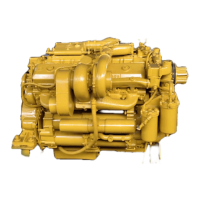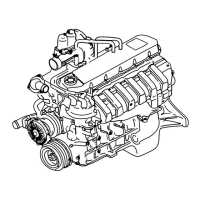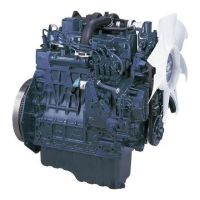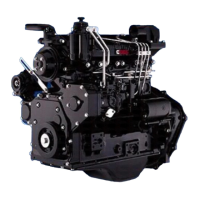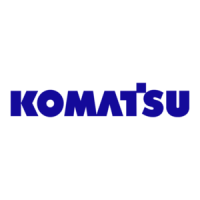
Do you have a question about the Komatsu 114E-3 Series and is the answer not in the manual?
| Engine Type | 4-cycle, water-cooled, direct injection |
|---|---|
| Aspiration | Turbocharged and aftercooled |
| Number of Cylinders | 6 |
| Fuel System | Direct injection |
| Gross Horsepower | 220 HP |
| Rated RPM | 2200 RPM |
| Engine Model | 114E-3 Series |
Provides an alphabetical listing of topics covered in the manual.
Explains the structure and organization of the shop manual and its components.
Covers important safety notices, how to read the manual, and general information.
Contains detailed technical specifications and data for the engine.
Lists the applicable machines for which this engine is used.
Details engine name, dimensions, performance, and key component specifications.
Provides visual representations of the engine from different sides.
Lists the dimensions (A, B, C) of the engine for various machine models.
Displays graphical data for engine torque and horsepower versus engine speed.
Describes the engine's intake and exhaust systems, including components like turbochargers.
Explains the general information, function, and types of turbochargers used.
Details the engine's lubricating oil system, including flow and lubrication points.
Outlines the engine's cooling system, general information, and components.
Covers the common rail fuel system, including components and operation.
Provides standard values and criteria for checking and maintaining engine components.
Presents standard and permissible values for engine tests and adjustments.
Detailed table of standard values for various engine performance and system checks.
Provides guidelines for engine run-in procedures and performance test criteria.
Introduces the section on testing and adjusting engine components and systems.
Lists the necessary tools for performing various tests and adjustments.
Details the procedure for testing the engine's air boost pressure.
Provides step-by-step instructions for adjusting the engine's valve clearance.
Explains the procedure for testing the engine's compression pressure.
Outlines the method for testing the engine's blow-by pressure.
Details the procedure for testing the engine's oil pressure.
Offers precautions for handling fuel system components during testing and maintenance.
Explains the procedure for safely releasing residual pressure in the fuel system.
Describes methods for testing fuel pressure in various circuits of the fuel system.
Explains how to operate the engine with reduced cylinder function to diagnose issues.
Details the procedure for engine cranking without injection for lubrication.
Outlines procedures for testing fuel system leaks and injector return rates.
Provides instructions for bleeding air from the fuel circuit using the electric priming pump.
Details the procedure for testing the fuel system for any leaks.
Offers precautions for safely handling the engine controller's high-voltage circuit.
Guides on how to replace the engine's alternator belt.
Provides general principles, procedures, and precautions for effective troubleshooting.
A comprehensive list of error codes, failure phenomena, and reference documents.
Explains how to interpret the troubleshooting tables and related circuit diagrams.
Details troubleshooting steps for electrical system errors related to E-mode.
Describes troubleshooting for engine controller internal failure.
Outlines troubleshooting for Ne and Bkup speed sensor errors.
Details troubleshooting for high charge air pressure sensor errors.
Provides troubleshooting for low charge air pressure sensor errors.
Outlines troubleshooting for high throttle sensor errors.
Details troubleshooting for low throttle sensor errors.
Describes troubleshooting for high coolant temperature sensor errors.
Provides troubleshooting for low coolant temperature sensor errors.
Outlines troubleshooting for high charge air temperature sensor errors.
Details troubleshooting for low charge air temperature sensor errors.
Explains troubleshooting for charge air pressure high speed derate.
Provides troubleshooting for low sensor power supply 2 voltage errors.
Outlines troubleshooting for high ambient air pressure sensor errors.
Details troubleshooting for low ambient air pressure sensor errors.
Explains troubleshooting for high levels in sensor power supply 2 circuits.
Covers troubleshooting for engine overspeed conditions.
Outlines troubleshooting for Ne speed sensor supply voltage errors.
Details troubleshooting for IMV (IMA) short circuit errors.
Provides troubleshooting for IMV (IMA) open circuit errors.
Explains troubleshooting for high pressure pump errors.
Outlines troubleshooting for injector No. 1 system open/short errors.
Details troubleshooting for injector No. 5 system open/short errors.
Provides troubleshooting for injector No. 3 system open/short errors.
Explains troubleshooting for injector No. 6 system open/short errors.
Outlines troubleshooting for injector No. 2 system open/short errors.
Details troubleshooting for injector No. 4 system open/short errors.
Provides troubleshooting for engine controller data matching errors.
Details troubleshooting steps for electrical system errors related to E-mode.
Outlines troubleshooting for injector drive circuit errors.
Details troubleshooting for low sensor supply 1 voltage errors.
Provides troubleshooting for high sensor supply 1 voltage errors.
Explains troubleshooting for high water sensor level errors.
Outlines troubleshooting for low water sensor level errors.
Details troubleshooting for idle validation switch errors.
Provides troubleshooting for idle validation process errors.
Explains troubleshooting for engine oil switch errors.
Outlines troubleshooting for low supply voltage errors.
Details troubleshooting for high supply voltage errors.
Provides troubleshooting for rail pressure high errors (type 2).
Explains troubleshooting for high rail pressure sensor errors.
Outlines troubleshooting for low rail pressure sensor errors.
Details troubleshooting for charge air temperature high torque derate.
Provides troubleshooting for rail pressure high errors (type 1).
Explains troubleshooting for low rail pressure errors.
Outlines troubleshooting for engine Ne speed sensor errors.
Details troubleshooting for engine Bkup speed sensor phase errors.
Provides troubleshooting for loss of all engine controller data.
Explains troubleshooting for engine Bkup speed sensor errors.
Outlines troubleshooting for KOMNET communication errors.
Details troubleshooting for high throttle sensor supply voltage errors.
Provides troubleshooting for low throttle sensor supply voltage errors.
Explains troubleshooting for very low rail pressure errors.
Outlines troubleshooting for abnormally high levels in the electric lift pump.
Details troubleshooting for abnormally low levels in the electric lift pump.
Provides troubleshooting for IMV (IMA) solenoid errors.
Explains troubleshooting for low supply voltage errors of the intake air heater relay.
Outlines troubleshooting for high supply voltage errors of the intake air heater relay.
Details troubleshooting for engine oil pressure low speed derate.
Provides troubleshooting for engine oil pressure low torque derate.
Explains troubleshooting for engine overheating issues.
Guides on troubleshooting mechanical system issues using S-mode procedures.
Explains how to effectively use the troubleshooting charts.
Addresses troubleshooting steps for poor engine starting performance.
Outlines causes and solutions when the engine fails to start.
Details troubleshooting for engines that do not accelerate smoothly.
Provides guidance on troubleshooting when the engine stops during operation.
Covers troubleshooting for engines that rotate unevenly.
Addresses troubleshooting for engines experiencing a lack of output or power.
Explains troubleshooting for black exhaust smoke indicating incomplete combustion.
Details troubleshooting for excessive oil consumption or blue exhaust smoke.
Outlines troubleshooting for engine oil that becomes contaminated rapidly.
Provides troubleshooting steps for excessive fuel consumption.
Addresses troubleshooting for oil contamination in the coolant system.
Details troubleshooting procedures for engine oil pressure drops.
Outlines troubleshooting for engine oil level rising due to coolant or fuel entry.
Provides troubleshooting for engine overheating issues.
Covers troubleshooting for abnormal noises originating from the engine.
Details troubleshooting steps for excessive engine vibration.
Provides general guidelines and symbols for disassembly and assembly procedures.
Explains how to interpret the symbols and structure of the disassembly/assembly sections.
Lists recommended adhesives, sealants, and greases for assembly tasks.
Details special tools required for engine disassembly and assembly.
Covers the initial stages of engine disassembly, starting with preparation.
Step-by-step guide for the general disassembly of the engine.
Covers the assembly procedures for engine components.
Step-by-step guide for the general assembly of the engine.

